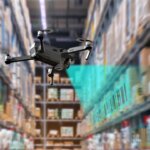Self-powered Bluetooth sensors support circular economy

|
Getting your Trinity Audio player ready...
|
Keeping track of what’s where and when is a common issue for all kinds of companies and organizations. Typical solutions include barcode scanning and RFID tags, but there’s another option that opens the door to real-time asset tracking. Israeli tech start-up Wiliot is commercializing self-powered Bluetooth sensors that can help customers secure supply chains and support circular business models.
Self-powered Bluetooth sensors in packaging
Being self-powered means that Bluetooth product sensors can last for ages. And they’re cheap too, as there are no batteries to pay for. Antony Yousefian, VP of Climate and Circularity at Wiliot, says that smart labels can have a lifetime in the order of five years. And he adds that the limit is the stickiness of the labels rather than the electronics inside.
Wiliot’s founders – Tal Tamir, Yaron Elboim, and Alon Yehezkely, who were all engineers at Intel earlier in their careers – formed the company after selling Wilocity, a designer of high-speed wireless data transmission chips, to Qualcomm. Their expertise in mobile communications hardware and protocols guides Wiliot on its mission to illuminate supply chains and enable an internet of everything, everywhere.
Supporting those efforts are millions of postage stamp-sized, battery-free sensors that the firm dubs IoT pixels. The wireless design, which is the world’s first Bluetooth-certified label, features an ARM Cortex-M0+ microcontroller IC and energy-harvesting antennae capable of scavenging power from radio frequencies above and below 1GHz.
As mentioned, the sensor’s energy harvesting capability allows it to be self-powered, but the fact that it runs over Bluetooth is important too. It means that the smart labels can operate using infrastructure that customers already have. RFID tags, on the other hand, require dedicated hardware, and the information they provide is more limited.
What’s more, Wiliot is working with standards groups such as 3GPP, which could make the integration of so-called Ambient IoT communications even more straightforward in coming technologies such as 6G.
The firm’s self-powered Bluetooth labels communicate product IDs, temperature, whereabouts, and more. Third generation tags coming this year add humidity information, and the firm intends to roll out further sensing capabilities such as being able to detect when products have been exposed to light.
The smart labels are the foundation, but Wiliot’s business model is built around providing event notifications to customers through its cloud-based visibility data platform. Subscribers use the service to transform raw sensor data into insights on their operations, with machine learning algorithms taking the heavy lifting out of spotting key trends in millions of data points.
Combining postage stamp-sized compute devices costing just a few cents – which can be stuck on medicines, food crates, clothing, and a huge number of other items – with event-based analytics, allows companies to keep track of their assets like never before. For example, they can check that inventory has been loaded and unloaded as planned, automatically, without barcode scanning. And the data supports temperature compliance monitoring.
#agtech coverage continues with📰story on using watermelons🍉and tomatoes🍅as molecular farms for producing natural sweetener, which looks at @EloLifeSystems product pipeline👇https://t.co/wLUoKt5ms9
— TechHQ (@techhq) September 7, 2023
Omnichannel retailers can improve their picking efficiency by having much greater visibility of where stock items are located across the organization. Also, self-powered Bluetooth sensors make it possible for retailers to set up real-time inventory systems capable of issuing replenishment alerts to avoid out-of-stock events.
Major investors in Wiliot, which has raised over $270 million in total funding, include Amazon. But it’s not just giant firms that can benefit from the technology. In some ways, ambient IoT could help to level the playing field, giving smaller companies the kinds of insights that only larger operators have been able to gather, up until now.
Circular economy technology
And when new materials and products become scarce, the self-power Bluetooth sensors could signal assets that are available or haven’t been used for a while. In the context of supporting the circular economy, you could imagine a scenario where sellers have the option to be alerted when buyers are looking for an item that they own. And this could play out across various categories of goods from clothing to car parts to smartphones and more.
Ambient IoT could operationalize sustainability in a number of ways, which speaks to Yousefian’s role at the tech firm. Understanding operations in more detail helps firms to reduce waste. “You can identify the optimal area in the supply chain to pull on for sustainability,” he told TechHQ.
Supply chains are traditionally operated on a first-in, first-out basis. But asset data could allow stakeholders to integrate sustainability into the decision-making process – a so-called ‘low carbon first’ approach.
Yousefian points out that swarms of smart labels make it possible to perform detailed environmental calculations in real-time. “You would be able to get a very certain carbon footprint,” he explains.
Rather than being an end-of-the-year audit, carbon footprinting could become dynamic and that information could be passed on to customers to inform their buying decisions. Yousefian has a video demonstration that shows what’s possible; CO2 levels can be seen growing on a map, along delivery routes, and at warehousing facilities.
As more stakeholders adopt the technology, dynamic data would make it possible to optimize routes deep into the supply chain, solving not just for materials security, but also to minimize climate impacts. And as operators better understand how individual processes contribute to their total emissions, they can make smarter decisions on where to invest.
For example, electrifying transport fleets might sound like the best next step, but the data could tell a different story. Having the numbers to hand and at a much more granular level means that decisions can be evidence-based and targeted. In the case of food distributors, it could turn out that improving the maintenance of cold stores may have a more positive impact in reducing the size of their carbon footprint.
Nature’s Bluetooth
Self-powered Bluetooth sensors bring intelligence to all kinds of products. But it’s worth adding that plants already respond to their environment and bring bio-intelligence to the table, we just need to be able to capture and understand those messages. Smart inks with gas-sensing and bio-marker recognition capabilities could provide steps in that direction. And ripeness detection is another property that’s on the roadmap for Wiliot’s engineering team.









